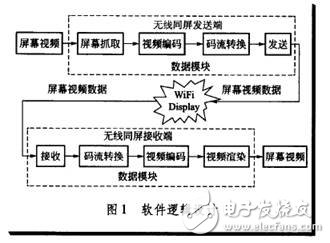1 Introduction
Wearable smart devices have moved from concept to commercialization. As the most representative intelligent device, smart glasses are based on short-range wireless transmission technology such as Bluetooth to realize wireless data communication. Miracast does not need to access any network, form a device to request video transmission through WiFi Direct, and use the IC-Route voice recognition module to achieve non-specific voice recognition. The overall design is simple and easy to operate, cost-effective, and integrates common functions and engineering into one.
2 wireless screen technology
2.1 Introduction to Wireless Same Screen Technology
Wireless on-screen is a technology for realizing screen video data transmission between devices through wireless transmission. Get rid of physical connections and increase flexibility compared to wired screens. There are two working modes for the current mobile intelligent terminal device (computer, Apple, Android mobile phone or portable computer, installed with Windows, iOS, Android system, that is, the transmitting end) to the large-screen TV and projector. It is an audio and video push service (non-real time, comply with AirPlay or DLNA protocol), and the other is the same screen, which is essentially a streaming media system in a local area network. The design uses the same screen technology to achieve the purpose of LAN interconnection, sharing information and tapping the potential of equipment.
Miracast is a WiFi wireless industry alliance to support WiFi Dis. The device authentication name of the play function, the user does not need to pick up any WiFi network. The multiple devices in the communication act as the interaction mode between the server and the client respectively. The data transmission rate reaches 300 Mb/s, the transmitted image is compressed, and the compression/decompression process is H. 264 format, the video display format is 1 080P?.

2.2 Wflq Display Architecture
WiFi Display is a standard old J that can communicate directly between devices without a WLAN connection. The bottom layer is based on WiFi Direct (WiFi Direct Connect), and the upper layer is composed of protocol stack software: service discovery and connection of device terminals are processed through WiFi Direct. The transport layer, control layer, and network layer of the management data stream are processed by Real Time Transport Protocol (RrIP), Real Time Streaming Protocol (RTSP), and TCP/UDP protocol, respectively. In addition, WPA2 security mechanism is adopted to ensure secure connection data transmission and file privacy. The specific software logic design is shown in Figure 1.
As a streaming video processing flow, the sender and receiver of the design have a symmetrical process. The transmitting end and the receiving end, under the control of the interaction protocol, pass the necessary communication process to negotiate whether to perform the same screen transmission, encoding and transmission parameters, and the process ensures the normal operation of the screen transmission. The receiving end statistically analyzes the relevant data in the process of receiving and processing the data packet, and performs information adjustment on the suggestions of the parameters and behaviors of the transmitting end including the compression encoding and quantization parameters. The sender performs the acquisition of the original screen video, H. 264 video encoding, H. The 264 video stream is converted and transmitted to the stream of the duck stream. The receiving end performs reception and the code flows to H. 264 video stream conversion, H. 264 video decoding and video rendering.
Battery Operated Led,LED Lighted Lantern,Led Swirling Lighting
XINGYONG XMAS OPTICAL (DONGGUAN ) CO., LTD , https://www.xingyongxmas.com